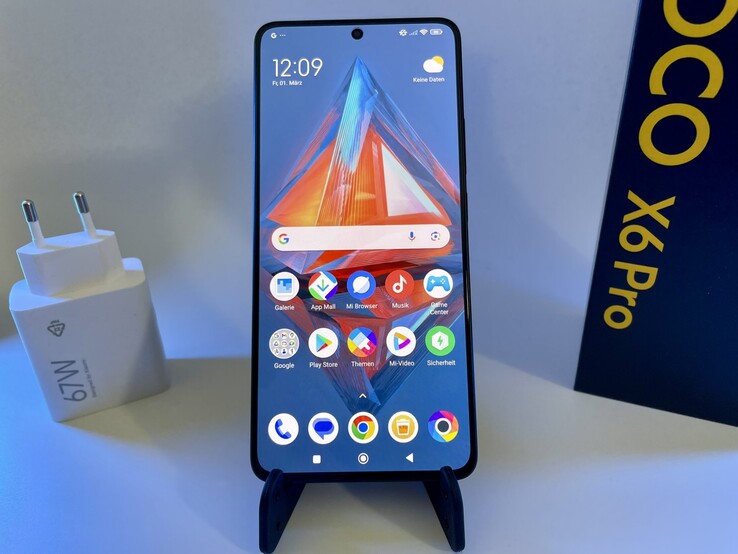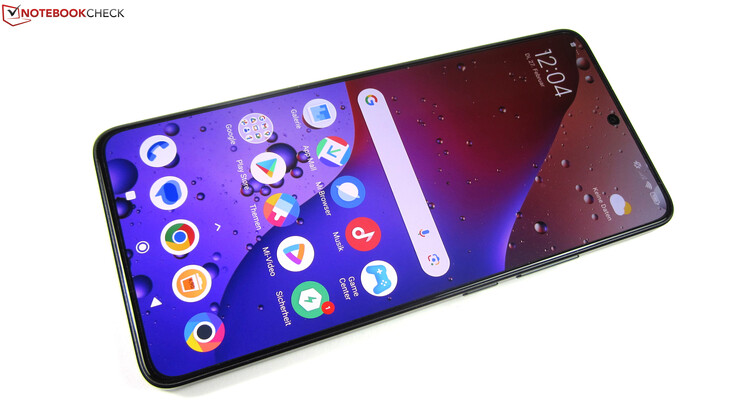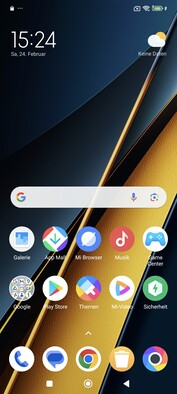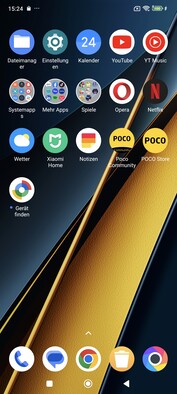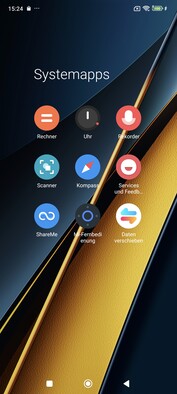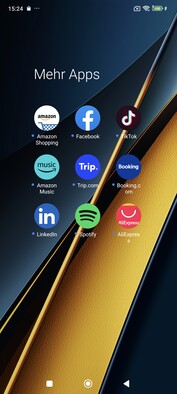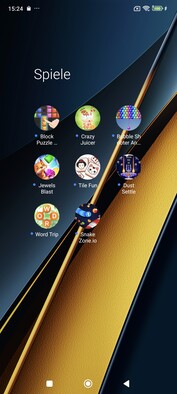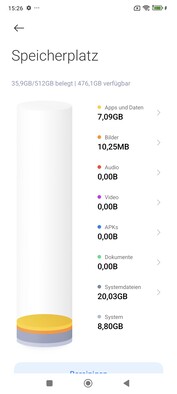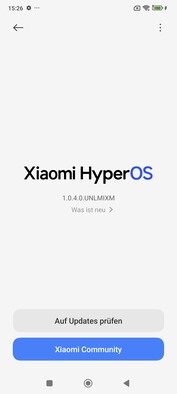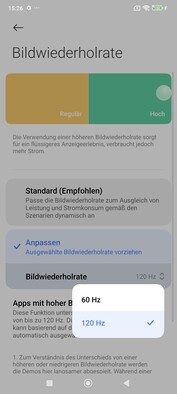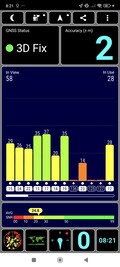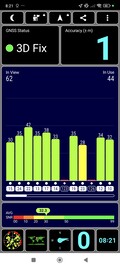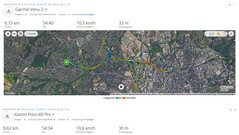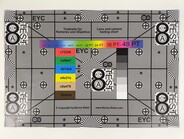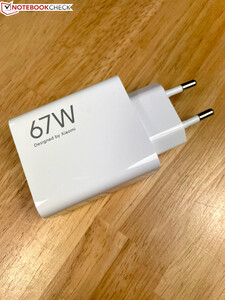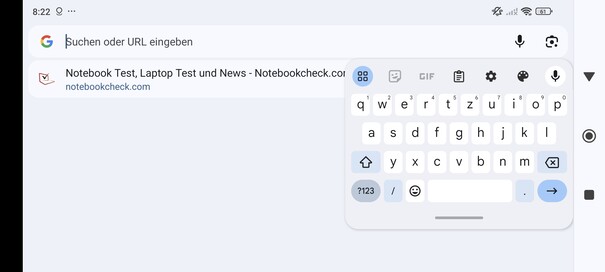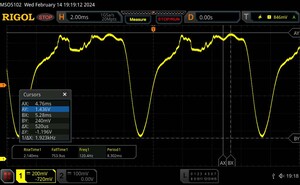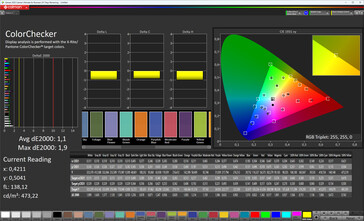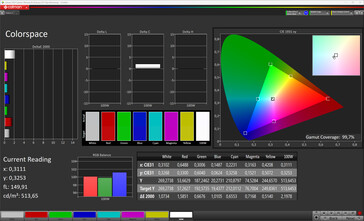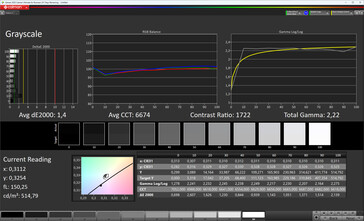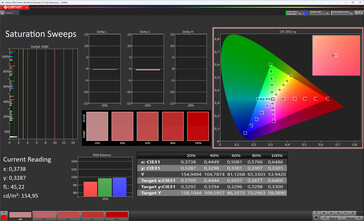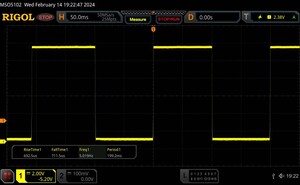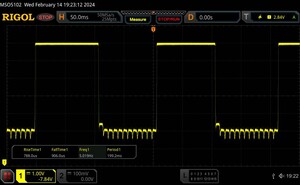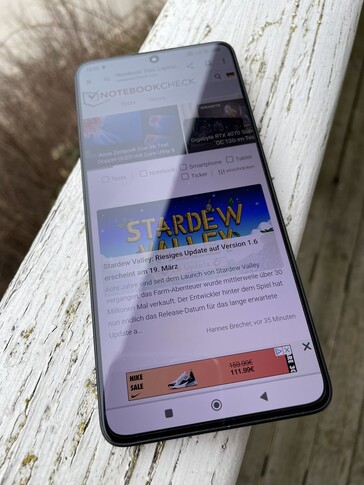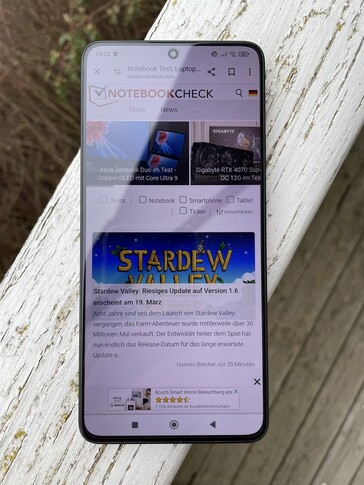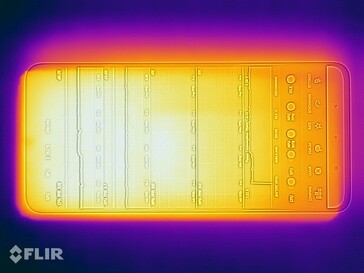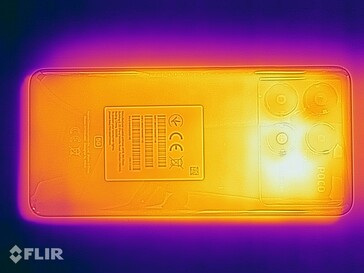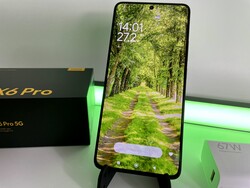Xiaomi Poco X6 Pro review - One of the best smartphones for less than 400 Euros
The Xiaomi Poco X6 Pro from Xiaomi's current Poco portfolio is very interesting for price-conscious buyers. The MediaTek Dimensity 8300-Ultra makes the 6.67-inch smartphone as powerful as a flagship from 2023. But this isn't reflected in the price, since the Poco X6 Pro officially starts from 350 Euros (~$380) and is already available for significantly less from some online vendors.
The rest of the equipment is also nothing to sneeze at, since the Poco X6 Pro offers up to 12 GB of RAM and 512 GB storage. This is accompanied by features such as an AMOLED panel with 120 Hz, quick-charging at 67 watts, HyperOS based on Android 14, and a triple-camera setup with 64 MP.
We find out in our test, how the Poco X6 Pro fares against its competitors.
Possible Competitors in Comparison
Rating | Date | Model | Weight | Drive | Size | Resolution | Price |
|---|---|---|---|---|---|---|---|
| 86.1 % v7 (old) | 03 / 2024 | Xiaomi Poco X6 Pro 5G Dimensity 8300-Ultra, Mali-G615 MP6 | 186 g | 512 GB UFS 4.0 Flash | 6.67" | 2712x1220 | |
| 87.1 % v7 (old) | 06 / 2023 | Google Pixel 7a Tensor G2, Mali-G710 MP7 | 193.5 g | 128 GB UFS 3.1 Flash | 6.10" | 2400x1080 | |
| 84.6 % v7 (old) | 10 / 2023 | Motorola Edge 40 Neo Dimensity 7030, Mali-G610 MP3 | 170 g | 256 GB UFS 3.1 Flash | 6.55" | 2400x1080 | |
| 86 % v7 (old) | 05 / 2023 | Samsung Galaxy A54 5G Exynos 1380, Mali-G68 MP5 | 202 g | 128 GB UFS 2.2 Flash | 6.40" | 2340x1080 | |
| 83.1 % v7 (old) | 09 / 2023 | Sony Xperia 10 V SD 695 5G, Adreno 619 | 159 g | 128 GB UFS 2.2 Flash | 6.10" | 2520x1080 |
Case - Also available in artificial leather
The Poco X6 Pro shows good workmanship and is comfortable to hold in the hand with its relatively low weight of 186 grams (~6.56 oz). Its back cover is rounded on all four sides and provides it with high-quality haptics, even though the matte frame and back cover are only made of plastic. Considering the price class, the workmanship offers no reason for complaint. In our test, the Poco X6 Pro can neither be warped nor pressed in, although it produces some slight creaking sounds when we try.
Its IP54 certification makes the Poco X6 Pro dust and splash resistant. In the state of delivery, the Gorilla Glas 5 protected display is also covered by a foil. Interestingly, the Poco X6 sibling model even offers Gorilla Glas Victus, although it places below the Poco X6 Pro in the internal Poco hierarchy.
The Black and Grey color versions of the slim, 8.25-mm (~0.325 in) Poco X6 Pro have a plastic back cover. Due to its shiny surface, it turns out to be a fingerprint magnet, as we find out after only a short time in our test. However, you can solve this problem by placing the smartphone inside the protective cover that is included in the box.
If you decide for the third, Yellow color version, the back is covered by artificial leather. The minimally higher weight of 190 grams (~6.7 oz) and slightly thicker case of 8.35 mm (~0.328 in) compared to the plastic version shouldn't really be noticeable or play any role in everyday operation. The wide camera module with its three lenses is black in all three color versions and only sticks out of the case by a few millimeters, in contrast to that of the Poco X6.
Equipment - Poco X6 Pro with up to 12 GB of RAM and 512 GB of storage
Xiaomi offers the Poco X6 Pro in two storage versions, both of which use LPDDR5X-RAM and fast UFS 4.0 storage.
- 8 GB RAM + 256 GB storage: 349.90 Euros (~$380)
- 12 GB RAM + 512 GB storage: 419.90 Euros (~$456)
While the rest of the Poco X6 Pro equipment is solid, there is still a considerable distance to that of more expensive models of the Xiaomi 13 and Xiaomi 14 series. For example, the OTG-capable USB-C port operates only at USB-2.0 speed, which is also confirmed by our copy test with the external Samsung 980 Pro SSD (29.86 MB/s). In addition, there is no notification LED, and the always-on display only remains active for 10 seconds after tapping on the display.
What is included is stereo speakers, a dual-SIM slot, and an infrared transmitter at the top of the smartphone, allowing you to control compatible devices such as smart TVs. However, it remains a mystery why only the Poco X6 includes a 3.5-mm audio port and not the Poco X6 Pro.
Software - HyperOS based on Android 14
The Poco X6 Pro includes Xiaomi's new HyperOS operating system that is based on Android 14. According to the manufacturer, the HyperOS kernel is a combination of Linux and the Vela IoT software. Externally, you can hardly see any difference to the MIUI user interface that has been used until now, and besides some minor adjustments in the visual appearance and menu structures, HyperOS looks just the same. The Poco X6 sibling model has to be content with MIUI 14 based on Android 13.
Xiaomi doesn't specify how long the Poco X6 Pro will be provided with OS upgrades and security updates. At the time of this test, the smartphone isn't listed yet in the Xiaomi Security Center, where you can usually find this information. However, we can assume 2 years of OS upgrades and 3 years of security updates for the Poco X6 Pro. But how often the updates occur is another question. We've seen in other Poco smartphones that some of the updates were rolled out at fairly irregular intervals.
Communication and GNSS - Poco X6 Pro with WiFi 6 and accurate GPS
The Poco X6 Pro offers good mobile frequency band coverage and supports all the usual standards including 5G Sub6. While the smartphone isn't a world traveler with its 16 4G and 14 5G bands, you shouldn't have any problems with reception in the EU countries.
Due to the MediaTek Dimensity 8300-Ultra, the Poco X6 Pro also supports modern communication standards such as Bluetooth 5.4 and WiFi 6. Both are rather rare in this price class, and this is also one step above the communication equipment of the Poco X6, which only offers WiFi 5 and Bluetooth 5.2.
When connected with our Asus ROG Rapture GT-AXE11000 reference router, the Poco X6 Pro shows a class-typical WiFi performance. Data transfers reach speeds up to 861 Mbit/s and remain stable to a large extent.
| Networking | |
| Xiaomi Poco X6 Pro 5G | |
| iperf3 receive AXE11000 | |
| iperf3 transmit AXE11000 | |
| Google Pixel 7a | |
| iperf3 receive AXE11000 | |
| iperf3 transmit AXE11000 | |
| iperf3 transmit AXE11000 6GHz | |
| iperf3 receive AXE11000 6GHz | |
| Motorola Edge 40 Neo | |
| iperf3 transmit AXE11000 6GHz | |
| iperf3 receive AXE11000 6GHz | |
| Samsung Galaxy A54 5G | |
| iperf3 receive AXE11000 | |
| iperf3 transmit AXE11000 | |
| Sony Xperia 10 V | |
| iperf3 receive AXE11000 | |
| iperf3 transmit AXE11000 | |
| Average of class Smartphone | |
| iperf3 receive AXE11000 | |
| iperf3 transmit AXE11000 | |
| iperf3 transmit AXE11000 6GHz | |
| iperf3 receive AXE11000 6GHz | |
To locate its position, the Poco X6 Pro uses the GPS (L1), Glonass (L1), Beidou (B1, B1C), Galileo (E1), and QZSS (L1) satellite navigation services, and this occurs mainly in the single-band. In our test, the smartphone determines our location with an accuracy of up to 2 meters (~6.6 ft) indoors, and the accuracy even increases up to 1 meter (~3.3 ft) outdoors.
In our practice test, the Poco X6 Pro turns out to be a good navigation device. Compared to the Garmin Venu 2 fitness smartwatch, it records our 10-kilometer (~6.2 miles) test route almost as accurately, although at times the position is recorded next to the route in some densely built-up areas. Overall, the precision is high.
Telephone Functions and Voice Quality
The Poco X6 Pro supports basic telephone functions such as VoLTE and making calls using the WLAN and is also able to accept two Nano-SIM cards. eSIM, on the other hand, is not supported.
In our test, the Xiaomi smartphone delivers a good voice quality and is able to filter out annoying background noises effectively even in noisy surroundings. This also works fairly well in speaker mode, although the voices then sound a bit duller.
Cameras - Triple-camera system with 64 MP
The selfie camera of the Poco X6 Pro is located behind a punch hole and has a resolution of 16 MP (f/2.4). Videos can be recorded at maximum in Full HD at 30 frames per second. Selfies taken with the 16-MP camera offer an image impression that is coherent overall and a decent sharpness as long as you don't exaggerate the amount of enlargement.
The Poco X6 Pro shares the same triple-camera system in the back with the Poco X6. The main camera offers a 64 MP resolution and uses the OmniVision OV64B (f/1.7) as image sensor that is also used in other Poco smartphones such as the Poco F5 Pro, for example. In the default setting, the main camera takes 16-MP pictures using 4x pixel binning. However, it is also able to use its full resolution for pictures in the 64-MP image mode.
If you use the main camera to take pictures in daylight, it will reward you with good recordings that score with vibrant colors and show many details. However, the fairly strong post-processing makes the colors look more intense and brighter than in the original scene, which can look unnatural at times. In addition, we note a tendency of the main camera to shift the colors towards red.
In pictures taken against the light (for example the picture of the cat lying down), the main camera is often unable to reproduce fine image details correctly, particularly if the object is further away. The effected image areas will then often blur together into a homogenous area. Low-light situations will quickly overextend the camera.
The main camera is able to record videos in up to 4K resolution at 30 frames per second. The quality of the recordings is similar. While recording, you can only change between the main and ultrawide angle camera up to a maximum resolution of 1080p and 30 frames per second with the HDR mode deactivated.
Subjectively, the 8-MP ultrawide angle camera produces even more intense colors than the main camera, but depending on the situation, it succeeds at in a more accurate color reproduction at times. However, the images quickly get blurry and washed out toward the edges. Overall, the ultrawide angle camera shows a solid average, class-typical performance.
You can argue about the point of the 2-MP Makro camera. In our opinion, you could have easily just left it out, particularly since the main camera achieves better-quality results in closeups with its 2x zoom.
Image comparison
Choose a scene and navigate within the first image. One click changes the position on touchscreens. One click on the zoomed-in image opens the original in a new window. The first image shows the scaled photograph of the test device.
Tageslicht-Aufnahme 1Tageslicht-Aufnahme 2Ultraweitwinkel5-facher ZoomLowlight-AufnahmeIn our test lab, the main camera shows that it is able to capture colors fairly accurately in optimal light conditions. In bright red and green color tones, the deviations from the ideal are slightly larger. The test chart is sharp and reproduced completely. However, this changes at 1 Lux residual light, since the color accuracy is then lost, and we can only make out the outlines of the test chart.
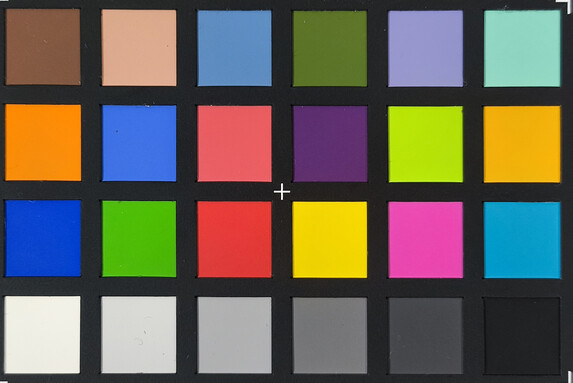
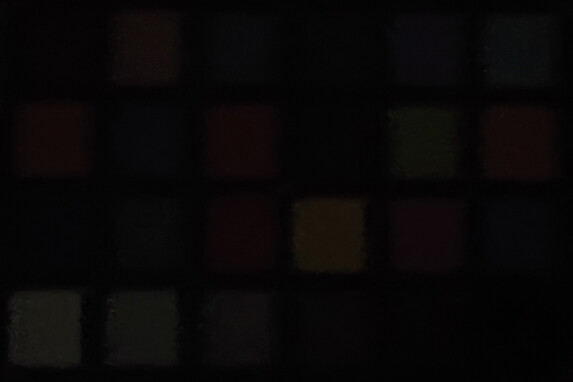
Accessories and Warranty - Poco X6 Pro with a 67-Watt charger
Input Devices and Operation - Touch scan rate up to 2160 Hz
The touchscreen of the Poco X6 Pro is scanned 480 times per second, responding very quickly to inputs regardless of their places on the screen. While gaming, the touch scan rate can even increase up to 2160 Hz. The 120-Hz refresh rate results in a smooth display, and the vibration motor offers precise haptic feedback.
The two physical keys of the smartphone protrude only minimally from the frame, but they can be found easily and offer crisp feedback. For easier operation, you can also activate a single-hand mode, which reduces the image area to around 60% of the overall display area.
If you pick up the smartphone, the position of the fingerprint sensor, which is placed underneath the display, will be marked on the display by default. Using it to unlock the smartphone succeeds quickly and reliably. Another option for biometric authentication is the less secure 2D face unlock. The face scan works just as quickly as logging in via fingerprint.
Display - AMOLED panel with up to 1800 Nits
The AMOLED panel of the Poco X6 Pro has a resolution of 2712x1220 pixels. With an image diagonal of 6.67 inches, this results in a high pixel density of 446 PPI. In addition to HDR10+, the display also supports HLG and Dolby Vision.
Depending on the contents displayed, the refresh rate is adjusted automatically to 60 or 120 Hz, but you can also adjust it manually to one of the two values in the display settings.
Xiaomi promises a maximum brightness of 1800 Nits for the AMOLED panel. In our test, this value is reached if we feed it with HDR contents. The maximum brightness will then reach an impressive 1820 cd/m².
Even without HDR, the display offers a very high brightness. With a pure white display background, the AMOLED panel reaches a brightness of 1035.4 cd/m² on average. With an even distribution of light and dark image areas (APL18 measurement), the brightness even increases up to 1254 cd/m². If you deactivate the brightness sensor, the display reaches a maximum brightness of 548 cd/m². At the lowest brightness level, we still measure 2.29 cd/m².
The AMOLED panel uses a very high PWM dimming frequency of 1920 Hz. With this, even users who are sensitive to pulse-width modulation should not have to expect any difficulties.
| |||||||||||||||||||||||||
Brightness Distribution: 96 %
Center on Battery: 1034 cd/m²
Contrast: ∞:1 (Black: 0 cd/m²)
ΔE ColorChecker Calman: 1.1 | ∀{0.5-29.43 Ø4.78}
ΔE Greyscale Calman: 1.4 | ∀{0.09-98 Ø5}
99.7% sRGB (Calman 2D)
Gamma: 2.22
CCT: 6674 K
| Xiaomi Poco X6 Pro 5G AMOLED, 2712x1220, 6.7" | Google Pixel 7a OLED, 2400x1080, 6.1" | Motorola Edge 40 Neo pOLED, 2400x1080, 6.6" | Samsung Galaxy A54 5G Super AMOLED, 2340x1080, 6.4" | Sony Xperia 10 V OLED, 2520x1080, 6.1" | |
|---|---|---|---|---|---|
| Screen | -8% | -49% | -43% | -6% | |
| Brightness middle (cd/m²) | 1034 | 1006 -3% | 966 -7% | 940 -9% | 933 -10% |
| Brightness (cd/m²) | 1035 | 1010 -2% | 957 -8% | 935 -10% | 944 -9% |
| Brightness Distribution (%) | 96 | 95 -1% | 97 1% | 99 3% | 97 1% |
| Black Level * (cd/m²) | |||||
| Colorchecker dE 2000 * | 1.1 | 1.1 -0% | 1.87 -70% | 2.4 -118% | 1.1 -0% |
| Colorchecker dE 2000 max. * | 1.9 | 2.5 -32% | 4.34 -128% | 3.2 -68% | 1.7 11% |
| Greyscale dE 2000 * | 1.4 | 1.5 -7% | 2.5 -79% | 2.2 -57% | 1.8 -29% |
| Gamma | 2.22 99% | 2.25 98% | 2.272 97% | 2.05 107% | 2.29 96% |
| CCT | 6674 97% | 6531 100% | 6582 99% | 6422 101% | 6611 98% |
* ... smaller is better
Screen Flickering / PWM (Pulse-Width Modulation)
| Screen flickering / PWM detected | 120 Hz | ||
The display backlight flickers at 120 Hz (worst case, e.g., utilizing PWM) . The frequency of 120 Hz is very low, so the flickering may cause eyestrain and headaches after extended use. In comparison: 53 % of all tested devices do not use PWM to dim the display. If PWM was detected, an average of 8149 (minimum: 5 - maximum: 343500) Hz was measured. | |||
Measurement series at a fixed zoom level and various brightness settings
If you select the Original Color Pro image mode and Warm color temperature, the AMOLED panel delivers an excellent image quality. In the preset Vivid mode, the panel adjusts its color reproduction and white balance to the displayed content.
Display Response Times
| ↔ Response Time Black to White | ||
|---|---|---|
| 1.4 ms ... rise ↗ and fall ↘ combined | ↗ 0.6925 ms rise | |
| ↘ 0.7115 ms fall | ||
| The screen shows very fast response rates in our tests and should be very well suited for fast-paced gaming. In comparison, all tested devices range from 0.1 (minimum) to 240 (maximum) ms. » 7 % of all devices are better. This means that the measured response time is better than the average of all tested devices (20.3 ms). | ||
| ↔ Response Time 50% Grey to 80% Grey | ||
| 1.69 ms ... rise ↗ and fall ↘ combined | ↗ 0.788 ms rise | |
| ↘ 0.906 ms fall | ||
| The screen shows very fast response rates in our tests and should be very well suited for fast-paced gaming. In comparison, all tested devices range from 0.165 (minimum) to 636 (maximum) ms. » 7 % of all devices are better. This means that the measured response time is better than the average of all tested devices (31.7 ms). | ||
Outdoors, the Poco X6 Pro AMOLED panel with stable viewing angles leaves a very good impression. Even in direct sunlight, the display contents still remain easily readable. However, at times the reflective surface can also become a hindrance.
Performance - Powerful overachiever in the midrange
In contrast to the Poco X6 that with the Snapdragon 7s Gen 2 uses a processor that is customary for its price class, the Poco X6 Pro clearly offers far from the usual fare with the MediaTek Dimensity 8300-Ultra.
The octa-core SoC, which was manufactured in the 4 nm process, simply outclasses all the other midrange smartphones of our competition in most tests. With results such as 1,465,265 points in AnTuTu v10, the MediaTek Dimensity 8300-Ultra would have been one of the fastest smartphone SoCs only last year. Its performance is still impressive this year and should be able to ensure it a place among the top-10 processors also in 2024.
In the synthetic benchmarks, the Poco X6 Pro places clearly at the top in most cases. Its competitors are able to keep up only in Crossmark, PCMark for Android, and in the single-core tests of Geekbench 5.5 and Geekbench 6.2.
| Antutu v10 - Total Score | |
| Average of class Smartphone (142748 - 3269237, n=152, last 2 years) | |
| Xiaomi Poco X6 Pro 5G | |
| Average MediaTek Dimensity 8300-Ultra (1399064 - 1465265, n=2) | |
| UL Procyon AI Inference for Android - Overall Score NNAPI | |
| Xiaomi Poco X6 Pro 5G | |
| Average MediaTek Dimensity 8300-Ultra (57997 - 64597, n=2) | |
| Google Pixel 7a | |
| Motorola Edge 40 Neo | |
| Average of class Smartphone (3769 - 81594, n=137, last 2 years) | |
| Samsung Galaxy A54 5G | |
| Sony Xperia 10 V | |
With the ARM Mali-G615 MP6, the Poco X6 Pro races far ahead of the competitors in the GPU tests. The strongest pursuer turns out to be the Google Pixel 7a, although it is never able to even come close to the Xiaomi smartphone.
GFXBench (DX / GLBenchmark) 2.7: T-Rex Onscreen | 1920x1080 T-Rex Offscreen
GFXBench 3.0: on screen Manhattan Onscreen OGL | 1920x1080 1080p Manhattan Offscreen
GFXBench 3.1: on screen Manhattan ES 3.1 Onscreen | 1920x1080 Manhattan ES 3.1 Offscreen
GFXBench: on screen Car Chase Onscreen | 1920x1080 Car Chase Offscreen | on screen Aztec Ruins High Tier Onscreen | 2560x1440 Aztec Ruins High Tier Offscreen | on screen Aztec Ruins Normal Tier Onscreen | 1920x1080 Aztec Ruins Normal Tier Offscreen | 3840x2160 4K Aztec Ruins High Tier Offscreen
| 3DMark / Wild Life Extreme Unlimited | |
| Xiaomi Poco X6 Pro 5G | |
| Google Pixel 7a | |
| Samsung Galaxy A54 5G | |
| Motorola Edge 40 Neo | |
| Sony Xperia 10 V | |
| 3DMark / Wild Life Extreme | |
| Xiaomi Poco X6 Pro 5G | |
| Google Pixel 7a | |
| Samsung Galaxy A54 5G | |
| Motorola Edge 40 Neo | |
| Sony Xperia 10 V | |
| 3DMark / Wild Life Unlimited Score | |
| Xiaomi Poco X6 Pro 5G | |
| Google Pixel 7a | |
| Samsung Galaxy A54 5G | |
| Motorola Edge 40 Neo | |
| Sony Xperia 10 V | |
| 3DMark / Sling Shot Extreme (ES 3.1) Unlimited Physics | |
| Xiaomi Poco X6 Pro 5G | |
| Google Pixel 7a | |
| Samsung Galaxy A54 5G | |
| Motorola Edge 40 Neo | |
| Sony Xperia 10 V | |
| 3DMark / Sling Shot Extreme (ES 3.1) Unlimited Graphics | |
| Xiaomi Poco X6 Pro 5G | |
| Google Pixel 7a | |
| Samsung Galaxy A54 5G | |
| Motorola Edge 40 Neo | |
| Sony Xperia 10 V | |
| 3DMark / Sling Shot Extreme (ES 3.1) Unlimited | |
| Xiaomi Poco X6 Pro 5G | |
| Google Pixel 7a | |
| Samsung Galaxy A54 5G | |
| Motorola Edge 40 Neo | |
| Sony Xperia 10 V | |
| GFXBench (DX / GLBenchmark) 2.7 / T-Rex Onscreen | |
| Xiaomi Poco X6 Pro 5G | |
| Motorola Edge 40 Neo | |
| Samsung Galaxy A54 5G | |
| Google Pixel 7a | |
| Sony Xperia 10 V | |
| GFXBench (DX / GLBenchmark) 2.7 / T-Rex Offscreen | |
| Xiaomi Poco X6 Pro 5G | |
| Google Pixel 7a | |
| Samsung Galaxy A54 5G | |
| Motorola Edge 40 Neo | |
| Sony Xperia 10 V | |
| GFXBench 3.0 / Manhattan Onscreen OGL | |
| Xiaomi Poco X6 Pro 5G | |
| Google Pixel 7a | |
| Samsung Galaxy A54 5G | |
| Motorola Edge 40 Neo | |
| Sony Xperia 10 V | |
| GFXBench 3.0 / 1080p Manhattan Offscreen | |
| Xiaomi Poco X6 Pro 5G | |
| Google Pixel 7a | |
| Samsung Galaxy A54 5G | |
| Motorola Edge 40 Neo | |
| Sony Xperia 10 V | |
| GFXBench 3.1 / Manhattan ES 3.1 Onscreen | |
| Xiaomi Poco X6 Pro 5G | |
| Google Pixel 7a | |
| Samsung Galaxy A54 5G | |
| Motorola Edge 40 Neo | |
| Sony Xperia 10 V | |
| GFXBench 3.1 / Manhattan ES 3.1 Offscreen | |
| Xiaomi Poco X6 Pro 5G | |
| Google Pixel 7a | |
| Samsung Galaxy A54 5G | |
| Motorola Edge 40 Neo | |
| Sony Xperia 10 V | |
| GFXBench / Car Chase Onscreen | |
| Xiaomi Poco X6 Pro 5G | |
| Google Pixel 7a | |
| Samsung Galaxy A54 5G | |
| Motorola Edge 40 Neo | |
| Sony Xperia 10 V | |
| GFXBench / Car Chase Offscreen | |
| Xiaomi Poco X6 Pro 5G | |
| Google Pixel 7a | |
| Samsung Galaxy A54 5G | |
| Motorola Edge 40 Neo | |
| Sony Xperia 10 V | |
| GFXBench / Aztec Ruins High Tier Onscreen | |
| Xiaomi Poco X6 Pro 5G | |
| Google Pixel 7a | |
| Samsung Galaxy A54 5G | |
| Motorola Edge 40 Neo | |
| Sony Xperia 10 V | |
| GFXBench / Aztec Ruins High Tier Offscreen | |
| Xiaomi Poco X6 Pro 5G | |
| Google Pixel 7a | |
| Samsung Galaxy A54 5G | |
| Motorola Edge 40 Neo | |
| Sony Xperia 10 V | |
| GFXBench / Aztec Ruins Normal Tier Onscreen | |
| Xiaomi Poco X6 Pro 5G | |
| Google Pixel 7a | |
| Samsung Galaxy A54 5G | |
| Motorola Edge 40 Neo | |
| Sony Xperia 10 V | |
| GFXBench / Aztec Ruins Normal Tier Offscreen | |
| Xiaomi Poco X6 Pro 5G | |
| Google Pixel 7a | |
| Samsung Galaxy A54 5G | |
| Motorola Edge 40 Neo | |
| Sony Xperia 10 V | |
| GFXBench / 4K Aztec Ruins High Tier Offscreen | |
| Xiaomi Poco X6 Pro 5G | |
| Google Pixel 7a | |
| Samsung Galaxy A54 5G | |
| Motorola Edge 40 Neo | |
| Sony Xperia 10 V | |
While surfing the Internet, the speed of the Poco X6 Pro is extremely fast for its price class. Subjectively, we get a similar impression, and even large websites load very quickly.
| Jetstream 2 - 2.0 Total Score | |
| Average of class Smartphone (23.8 - 387, n=153, last 2 years) | |
| Xiaomi Poco X6 Pro 5G (Chrome 122.0.6261.64) | |
| Google Pixel 7a (Chrome 114) | |
| Motorola Edge 40 Neo (Chrome 118) | |
| Average MediaTek Dimensity 8300-Ultra (70.6 - 134, n=2) | |
| Samsung Galaxy A54 5G (Chrome 112) | |
| Sony Xperia 10 V (Chrome 116) | |
| Speedometer 2.0 - Result 2.0 | |
| Average of class Smartphone (15.2 - 643, n=129, last 2 years) | |
| Xiaomi Poco X6 Pro 5G (Chrome 122.0.6261.64) | |
| Average MediaTek Dimensity 8300-Ultra (117 - 180, n=2) | |
| Google Pixel 7a (Chrome 114) | |
| Motorola Edge 40 Neo (Chrome 118) | |
| Sony Xperia 10 V (Chrome 116) | |
| Samsung Galaxy A54 5G (Chrome 112) | |
| WebXPRT 4 - Overall | |
| Average of class Smartphone (27 - 306, n=147, last 2 years) | |
| Xiaomi Poco X6 Pro 5G (Chrome 122.0.6261.64) | |
| Average MediaTek Dimensity 8300-Ultra (103 - 140, n=2) | |
| Google Pixel 7a (Chrome 114) | |
| Motorola Edge 40 Neo (Chrome 118) | |
| Samsung Galaxy A54 5G (Chrome 112) | |
| Sony Xperia 10 V (Chrome 116) | |
| WebXPRT 3 - Overall | |
| Average of class Smartphone (38 - 380, n=38, last 2 years) | |
| Xiaomi Poco X6 Pro 5G (Chrome 122.0.6261.64) | |
| Average MediaTek Dimensity 8300-Ultra (n=1) | |
| Samsung Galaxy A54 5G (Chrome 112) | |
| Motorola Edge 40 Neo (Chrome 118) | |
| Octane V2 - Total Score | |
| Average of class Smartphone (2228 - 121337, n=200, last 2 years) | |
| Xiaomi Poco X6 Pro 5G (Chrome 122.0.6261.64) | |
| Google Pixel 7a (Chrome 114) | |
| Average MediaTek Dimensity 8300-Ultra (35853 - 46286, n=2) | |
| Motorola Edge 40 Neo (Chrome 118) | |
| Samsung Galaxy A54 5G (Chrome 112) | |
| Sony Xperia 10 V (Chrome 116) | |
| Mozilla Kraken 1.1 - Total | |
| Average MediaTek Dimensity 8300-Ultra (1007 - 1899, n=2) | |
| Sony Xperia 10 V (Chrome 116) | |
| Motorola Edge 40 Neo (Chrome 118) | |
| Samsung Galaxy A54 5G (Chrome 112) | |
| Average of class Smartphone (257 - 28190, n=155, last 2 years) | |
| Xiaomi Poco X6 Pro 5G (Chrome 122.0.6261.64) | |
| Google Pixel 7a (Chrome 114) | |
* ... smaller is better
With fast UFS 4.0 storage, the Poco X6 Pro reaches very high data transfer rates and impresses with very short load times. No other smartphone in our comparison performs as well.
| Xiaomi Poco X6 Pro 5G | Google Pixel 7a | Motorola Edge 40 Neo | Samsung Galaxy A54 5G | Sony Xperia 10 V | Average 512 GB UFS 4.0 Flash | Average of class Smartphone | |
|---|---|---|---|---|---|---|---|
| AndroBench 3-5 | -53% | -52% | -74% | -73% | -4% | -34% | |
| Sequential Read 256KB (MB/s) | 3824.7 | 1624.39 -58% | 1004.4 -74% | 528.32 -86% | 444.54 -88% | 3675 ? -4% | 2222 ? -42% |
| Sequential Write 256KB (MB/s) | 3642.57 | 996.44 -73% | 930.9 -74% | 335.39 -91% | 438.02 -88% | 3072 ? -16% | 1838 ? -50% |
| Random Read 4KB (MB/s) | 355.7 | 229.44 -35% | 279.5 -21% | 236.23 -34% | 175.72 -51% | 382 ? 7% | 295 ? -17% |
| Random Write 4KB (MB/s) | 467.74 | 263.81 -44% | 284.1 -39% | 70.52 -85% | 165.15 -65% | 463 ? -1% | 336 ? -28% |
Gaming - 60 FPS are practically guaranteed
We evaluate how the Poco X6 Pro handles gaming by looking at a small selection of games. We determine the frame rates with our Gamebench test tool. Some of the drops in the frame rates that can be observed at the beginning and end of the measurements have to do with the start and stop of the FPS recording of Gamebench, so they can be ignored.
Current games such as PUBG Mobile can also be played in maximum detail settings at 60 FPS. As its maximum graphics setting, PUBG Mobile allows for UltraHDR/Ultra and even offers a 90 FPS mode in the lowest Smooth detail level.
Even the demanding Genshin Impact runs at 60 frames per second in the highest detail level. Although there could have been even noticeably higher frame rates, the maximum frame rate doesn't change even in low detail settings.
Emissions - Poco X6 Pro with stereo speakers
Temperatures
As our temperature stress test, we submit the Poco X6 Pro to the demanding Burnout benchmark for one hour. During this time, the surface temperatures increase up to 43.7 °C (111 °F). This is still within a thermally green range and even rather low, considering the performance potential of the MediaTek Dimensity 8300-Ultra.
When put under a high load, the processor responds with throttling already after a short time. The stress test with 3DMark Wild Life shows that after 20 runs of the benchmark, it is only able to use around 2/3 of its initial performance. However, this isn't much of a problem, since even then, the Poco X6 Pro still offers a higher performance than its similarly priced competitors.
(±) The maximum temperature on the upper side is 43.7 °C / 111 F, compared to the average of 35.2 °C / 95 F, ranging from 21.9 to 247 °C for the class Smartphone.
(±) The bottom heats up to a maximum of 40.7 °C / 105 F, compared to the average of 34 °C / 93 F
(+) In idle usage, the average temperature for the upper side is 26.3 °C / 79 F, compared to the device average of 32.9 °C / 91 F.
3DMark Wild Life Stress Test
| 3DMark | |
| Wild Life Stress Test Stability | |
| Sony Xperia 10 V | |
| Motorola Edge 40 Neo | |
| Samsung Galaxy A54 5G | |
| Xiaomi Poco X6 Pro 5G | |
| Google Pixel 7a | |
| Wild Life Extreme Stress Test | |
| Samsung Galaxy A54 5G | |
| Motorola Edge 40 Neo | |
| Sony Xperia 10 V | |
| Xiaomi Poco X6 Pro 5G | |
| Google Pixel 7a | |
| Solar Bay Stress Test Stability | |
| Xiaomi Poco X6 Pro 5G | |
Speakers
The Poco X6 Pro has stereo speakers that can get fairly loud at around 90 dB(A), producing a smartphone-typical sound spectrum. The mids and highs are reproduced cleanly, while bass sounds are practically inaudible.
For sound output to external devices, you can use either the USB-C port or Bluetooth 5.4. With AAC, SBC, LDAC, aptX, aptX HD, aptX Adaptive, and TWS+ as well as LHDC V1 to V5, the Poco X6 Pro supports many current Bluetooth codecs.
Xiaomi Poco X6 Pro 5G audio analysis
(+) | speakers can play relatively loud (90.3 dB)
Bass 100 - 315 Hz
(-) | nearly no bass - on average 27.1% lower than median
(±) | linearity of bass is average (7.9% delta to prev. frequency)
Mids 400 - 2000 Hz
(±) | reduced mids - on average 6.1% lower than median
(+) | mids are linear (5% delta to prev. frequency)
Highs 2 - 16 kHz
(+) | balanced highs - only 4.1% away from median
(+) | highs are linear (3.6% delta to prev. frequency)
Overall 100 - 16.000 Hz
(±) | linearity of overall sound is average (18.1% difference to median)
Compared to same class
» 16% of all tested devices in this class were better, 9% similar, 75% worse
» The best had a delta of 11%, average was 35%, worst was 134%
Compared to all devices tested
» 37% of all tested devices were better, 8% similar, 55% worse
» The best had a delta of 4%, average was 24%, worst was 134%
Samsung Galaxy A54 5G audio analysis
(+) | speakers can play relatively loud (88.7 dB)
Bass 100 - 315 Hz
(-) | nearly no bass - on average 23.2% lower than median
(±) | linearity of bass is average (11.3% delta to prev. frequency)
Mids 400 - 2000 Hz
(±) | reduced mids - on average 6.4% lower than median
(+) | mids are linear (5.5% delta to prev. frequency)
Highs 2 - 16 kHz
(±) | higher highs - on average 6% higher than median
(+) | highs are linear (2.8% delta to prev. frequency)
Overall 100 - 16.000 Hz
(±) | linearity of overall sound is average (17.8% difference to median)
Compared to same class
» 14% of all tested devices in this class were better, 8% similar, 78% worse
» The best had a delta of 11%, average was 35%, worst was 134%
Compared to all devices tested
» 35% of all tested devices were better, 8% similar, 57% worse
» The best had a delta of 4%, average was 24%, worst was 134%
Battery Life - A complete recharge in 50 minutes
Power Consumption
The 5000-mAh battery of the Poco X6 Pro can be recharged at up to 67 watts using the included charger. In our test, a full charging cycle takes 50 minutes with this, with 85% of the battery level reached after 37 minutes. The Xiaomi smartphone doesn't support wireless charging.
Under load, the Poco X6 Pro consumes 12.3 watts on average, producing a performance that is more than twice as high as that of the comparison devices. However, you also have to consider that we determined the power consumption using the Burnout benchmark here, while the less demanding Stability Test was used for the comparison devices.
| Off / Standby | |
| Idle | |
| Load |
|
Key:
min: | |
| Xiaomi Poco X6 Pro 5G 5000 mAh | Google Pixel 7a 4385 mAh | Motorola Edge 40 Neo 5000 mAh | Samsung Galaxy A54 5G 5000 mAh | Sony Xperia 10 V 5000 mAh | Average MediaTek Dimensity 8300-Ultra | Average of class Smartphone | |
|---|---|---|---|---|---|---|---|
| Power Consumption | 32% | 18% | 12% | 41% | 10% | 6% | |
| Idle Minimum * (Watt) | 1.11 | 0.62 44% | 1 10% | 0.75 32% | 0.56 50% | 1.04 ? 6% | 0.849 ? 24% |
| Idle Average * (Watt) | 1.14 | 0.87 24% | 1.2 -5% | 1.51 -32% | 0.91 20% | 1.13 ? 1% | 1.43 ? -25% |
| Idle Maximum * (Watt) | 1.16 | 0.95 18% | 1.3 -12% | 1.62 -40% | 0.98 16% | 1.175 ? -1% | 1.612 ? -39% |
| Load Average * (Watt) | 12.33 | 6.11 50% | 5.2 58% | 4.91 60% | 5.34 57% | 8.23 ? 33% | 7.08 ? 43% |
| Load Maximum * (Watt) | 15.34 | 11.81 23% | 9.2 40% | 8.93 42% | 5.46 64% | 13.8 ? 10% | 11.2 ? 27% |
* ... smaller is better
Power Consumption: Geekbench (150 cd/m²)
Power Consumption: GFXBench (150 cd/m²)
Battery Life
In our realistic battery runtime tests that we perform with an adjusted brightness of 150 cd/m², the Poco X6 Pro does well. However, with 15:42 hours of simulated web surfing and 16:07 hours playing an HD video in a constant loop, the smartphone is still surpassed by most of its competitors. But a whole day of intensive usage still shouldn't pose any problems. And once the battery is low, the smartphone can also be recharged quickly.
| Xiaomi Poco X6 Pro 5G 5000 mAh | Google Pixel 7a 4385 mAh | Motorola Edge 40 Neo 5000 mAh | Samsung Galaxy A54 5G 5000 mAh | Sony Xperia 10 V 5000 mAh | |
|---|---|---|---|---|---|
| Battery runtime | -3% | 23% | 28% | 67% | |
| Reader / Idle (h) | 30.3 | 22.1 -27% | 40.7 34% | 43.2 43% | 67.8 124% |
| H.264 (h) | 16.1 | 20.4 27% | 20.5 27% | 25.1 56% | 26.9 67% |
| WiFi v1.3 (h) | 15.7 | 13.7 -13% | 14.4 -8% | 15.7 0% | 19.3 23% |
| Load (h) | 4.2 | 4.2 0% | 5.9 40% | 4.7 12% | 6.5 55% |
Pros
Cons
Verdict on the Xiaomi Poco X6 Pro
With its Poco series, Xiaomi offers smartphones that traditionally distinguish themselves with a good price-performance ratio. Although you have to live without refinements such as a glass back or equipment features such as eSIM support, a USB-3.x port, or a full always-on display, you still get a solid technology for a relatively small amount of money.
While the Xiaomi Poco X6 Pro offers exactly that, it also ups its game in terms of the performance. With the MediaTek Dimensity 8300-Ultra, it is as fast as a high-end smartphone, leaving other current smartphones of its price class up to 400 Euros (~$434) far behind in the dust.
In our test, the Xiaomi Poco X6 Pro impresses with its good price-performance ratio and extensive equipment. Particularly its performance is more than convincing.
The Poco X6 Pro is also able to score in our test with its fast, 120-Hz AMOLED panel that reaches four-digit brightness levels with SDR contents and increases those up to 1800 Nits with HDR. In addition, with WiFi 6, Bluetooth 5.4, and dual-SIM support, the Xiaomi also offers modern communication equipment. Its good battery life also earns it some additional points.
But of course, the Poco X6 Pro isn't able to hide its midrange origins completely. The clearest places where you can notice this are the plastic case and the camera. While the latter takes decent pictures in daylight conditions, it is unable to rise above a class-typical level.
Alternatives to the Xiaomi Poco X6 Pro are for example the Google Pixel 7a and the Samsung Galaxy A54. Even though both are slower, they offer a significantly longer update period than the Xiaomi.
Price and Availability
In the UK, the Poco X6 Pro can be purchased for £369 from Xiaomi's webstore, and in India for example from Flipcart for IRS 25,999. While it is available in Asia and some European countries, it is currently not available in the US.
Xiaomi Poco X6 Pro 5G
- 03/04/2024 v7 (old)
Manuel Masiero
Transparency
The selection of devices to be reviewed is made by our editorial team. The test sample was provided to the author as a loan by the manufacturer or retailer for the purpose of this review. The lender had no influence on this review, nor did the manufacturer receive a copy of this review before publication. There was no obligation to publish this review. As an independent media company, Notebookcheck is not subjected to the authority of manufacturers, retailers or publishers.
This is how Notebookcheck is testing
Every year, Notebookcheck independently reviews hundreds of laptops and smartphones using standardized procedures to ensure that all results are comparable. We have continuously developed our test methods for around 20 years and set industry standards in the process. In our test labs, high-quality measuring equipment is utilized by experienced technicians and editors. These tests involve a multi-stage validation process. Our complex rating system is based on hundreds of well-founded measurements and benchmarks, which maintains objectivity. Further information on our test methods can be found here.




